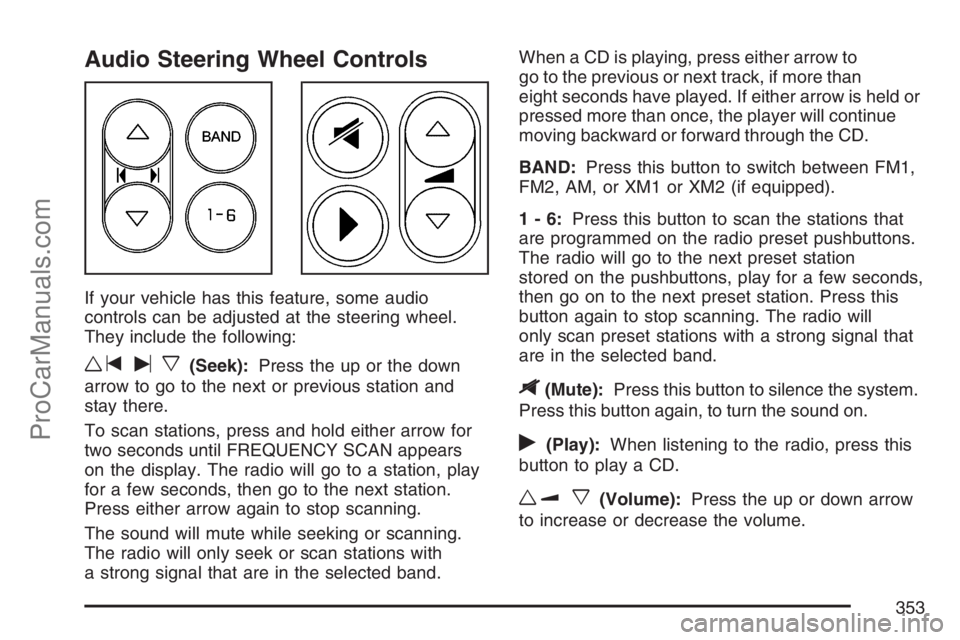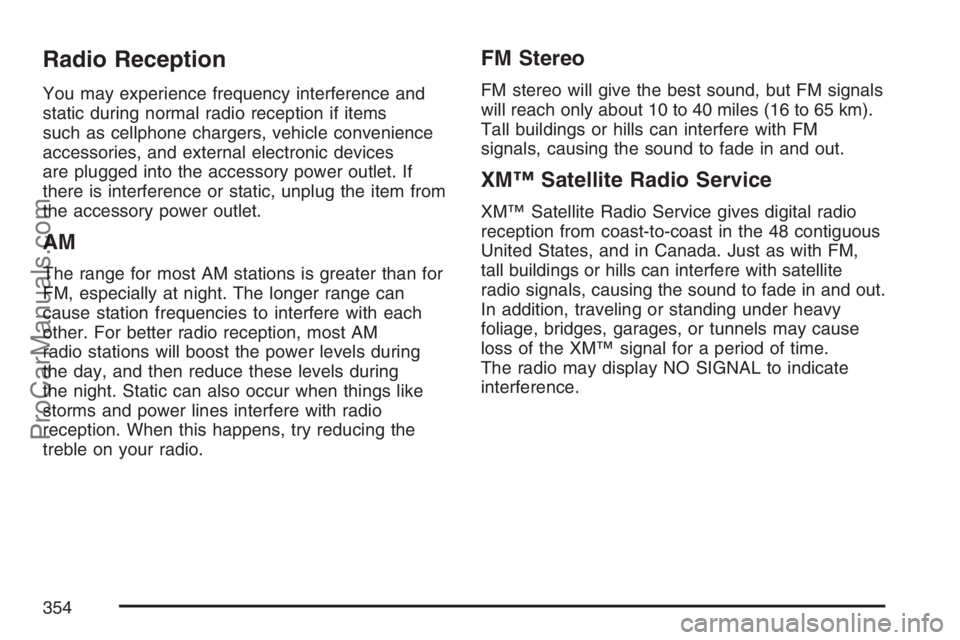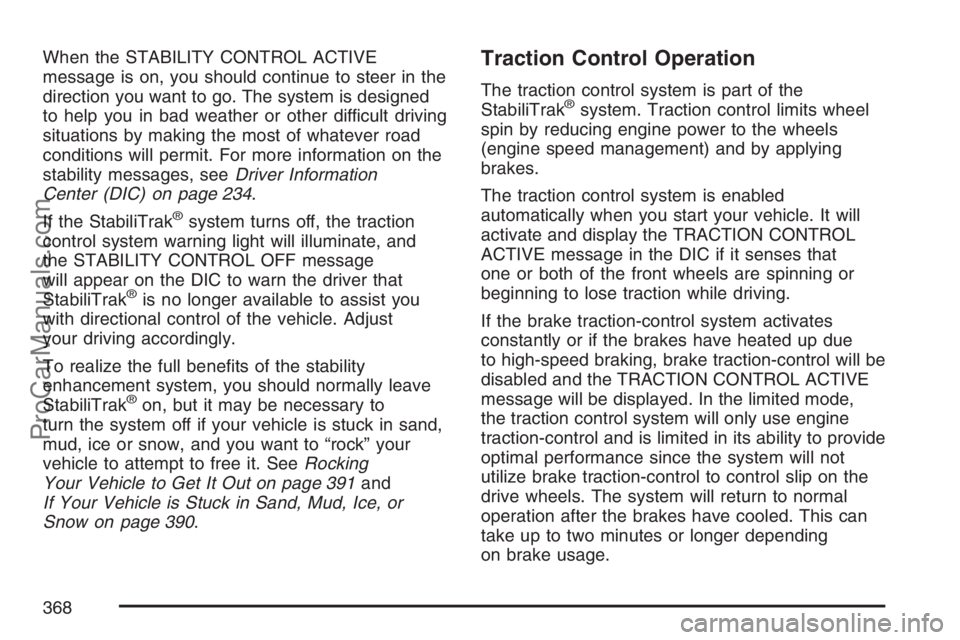display SATURN RELAY 2007 Owners Manual
[x] Cancel search | Manufacturer: SATURN, Model Year: 2007, Model line: RELAY, Model: SATURN RELAY 2007Pages: 570, PDF Size: 3.41 MB
Page 353 of 570

Audio Steering Wheel Controls
If your vehicle has this feature, some audio
controls can be adjusted at the steering wheel.
They include the following:
wtux(Seek):Press the up or the down
arrow to go to the next or previous station and
stay there.
To scan stations, press and hold either arrow for
two seconds until FREQUENCY SCAN appears
on the display. The radio will go to a station, play
for a few seconds, then go to the next station.
Press either arrow again to stop scanning.
The sound will mute while seeking or scanning.
The radio will only seek or scan stations with
a strong signal that are in the selected band.When a CD is playing, press either arrow to
go to the previous or next track, if more than
eight seconds have played. If either arrow is held or
pressed more than once, the player will continue
moving backward or forward through the CD.
BAND:Press this button to switch between FM1,
FM2, AM, or XM1 or XM2 (if equipped).
1-6:Press this button to scan the stations that
are programmed on the radio preset pushbuttons.
The radio will go to the next preset station
stored on the pushbuttons, play for a few seconds,
then go on to the next preset station. Press this
button again to stop scanning. The radio will
only scan preset stations with a strong signal that
are in the selected band.
$(Mute):Press this button to silence the system.
Press this button again, to turn the sound on.
r(Play):When listening to the radio, press this
button to play a CD.
wux(Volume):Press the up or down arrow
to increase or decrease the volume.
353
ProCarManuals.com
Page 354 of 570

Radio Reception
You may experience frequency interference and
static during normal radio reception if items
such as cellphone chargers, vehicle convenience
accessories, and external electronic devices
are plugged into the accessory power outlet. If
there is interference or static, unplug the item from
the accessory power outlet.
AM
The range for most AM stations is greater than for
FM, especially at night. The longer range can
cause station frequencies to interfere with each
other. For better radio reception, most AM
radio stations will boost the power levels during
the day, and then reduce these levels during
the night. Static can also occur when things like
storms and power lines interfere with radio
reception. When this happens, try reducing the
treble on your radio.
FM Stereo
FM stereo will give the best sound, but FM signals
will reach only about 10 to 40 miles (16 to 65 km).
Tall buildings or hills can interfere with FM
signals, causing the sound to fade in and out.
XM™ Satellite Radio Service
XM™ Satellite Radio Service gives digital radio
reception from coast-to-coast in the 48 contiguous
United States, and in Canada. Just as with FM,
tall buildings or hills can interfere with satellite
radio signals, causing the sound to fade in and out.
In addition, traveling or standing under heavy
foliage, bridges, garages, or tunnels may cause
loss of the XM™ signal for a period of time.
The radio may display NO SIGNAL to indicate
interference.
354
ProCarManuals.com
Page 356 of 570

XM™ Satellite Radio Antenna
System
The XM™ Satellite Radio antenna is located on
the roof of your vehicle. Keep this antenna clear of
snow and ice build up for clear radio reception.
Loading items onto the roof of your vehicle
can interfere with the performance of the XM™
system. Make sure that the XM™ satellite antenna
is not obstructed.
Chime Level Adjustment
The radio is used to adjust the vehicle’s chime
level. To change the volume level of the chime,
press and hold pushbutton 6 with the ignition
on and the radio power off. The volume level will
change from the normal level to loud, and
LOUD will appear on the radio display. To change
back to the default or normal setting, press and
hold pushbutton 6 again. The volume level
will change from the loud level to normal, and
NORMAL will appear on the radio display.
Removing the radio and not replacing it with a
factory radio or chime module will disable vehicle
chimes.
356
ProCarManuals.com
Page 367 of 570

You can turn the system back on at any time by
pressing the button again. The traction control
system warning message should go off.
Adding non-Saturn accessories can affect your
vehicle’s performance. SeeAccessories and
Modi�cations on page 412for more information.
StabiliTrak®System
Your vehicle is equipped with StabiliTrak®which
combines anti-lock brake, traction and stability
control systems and helps the driver maintain
directional control of the vehicle in most driving
conditions.
When you �rst start your vehicle and begin to
drive away, the system performs several diagnostic
checks to insure there are no problems. You
may hear or feel the system working. This
is normal and does not mean there is a problem
with your vehicle.
If the system fails to turn on or activate, the
SERVICE STABILITY SYSTEM message will be
displayed on the Driver Information Center (DIC).If the vehicle has gone through heavy acceleration
or braking or multiple turns during the �rst two miles
of driving after starting your vehicle, the STABILITY
CONTROL OFF message may appear on the DIC.
If this is the case, your vehicle does not need
servicing. You will need to turn the vehicle off and
then restart it to initialize StabiliTrak
®. If either
message appears on the DIC, and your vehicle has
not gone through hard acceleration, braking or
multiple turns in the �rst two miles of driving, your
vehicle should be taken in for service.
The STABILITY CONTROL ACTIVE message will
appear on the DIC only when the system is
both on and activated. It means that an advanced
computer-controlled system has come on to
help your vehicle continue to go in the direction in
which you are steering. StabiliTrak
®activates
when the computer senses that your vehicle is just
starting to spin, as it might if you hit a patch of
ice or other slippery spot on the road. When
the system activates, you may hear a noise or feel
a vibration in the brake pedal. This is normal.
367
ProCarManuals.com
Page 368 of 570

When the STABILITY CONTROL ACTIVE
message is on, you should continue to steer in the
direction you want to go. The system is designed
to help you in bad weather or other difficult driving
situations by making the most of whatever road
conditions will permit. For more information on the
stability messages, seeDriver Information
Center (DIC) on page 234.
If the StabiliTrak
®system turns off, the traction
control system warning light will illuminate, and
the STABILITY CONTROL OFF message
will appear on the DIC to warn the driver that
StabiliTrak
®is no longer available to assist you
with directional control of the vehicle. Adjust
your driving accordingly.
To realize the full bene�ts of the stability
enhancement system, you should normally leave
StabiliTrak
®on, but it may be necessary to
turn the system off if your vehicle is stuck in sand,
mud, ice or snow, and you want to “rock” your
vehicle to attempt to free it. SeeRocking
Your Vehicle to Get It Out on page 391and
If Your Vehicle is Stuck in Sand, Mud, Ice, or
Snow on page 390.
Traction Control Operation
The traction control system is part of the
StabiliTrak®system. Traction control limits wheel
spin by reducing engine power to the wheels
(engine speed management) and by applying
brakes.
The traction control system is enabled
automatically when you start your vehicle. It will
activate and display the TRACTION CONTROL
ACTIVE message in the DIC if it senses that
one or both of the front wheels are spinning or
beginning to lose traction while driving.
If the brake traction-control system activates
constantly or if the brakes have heated up due
to high-speed braking, brake traction-control will be
disabled and the TRACTION CONTROL ACTIVE
message will be displayed. In the limited mode,
the traction control system will only use engine
traction-control and is limited in its ability to provide
optimal performance since the system will not
utilize brake traction-control to control slip on the
drive wheels. The system will return to normal
operation after the brakes have cooled. This can
take up to two minutes or longer depending
on brake usage.
368
ProCarManuals.com
Page 418 of 570

{CAUTION:
If you spill fuel and then something
ignites it, you could be badly burned.
Fuel can spray out on you if you open
the fuel cap too quickly. This spray can
happen if your tank is nearly full, and is
more likely in hot weather. Open the fuel
cap slowly and wait for any hiss noise to
stop. Then unscrew the cap all the way.
Be careful not to spill fuel. Do not top off or
over�ll the tank and wait a few seconds after
you have �nished pumping before removing the
nozzle. Clean fuel from painted surfaces as
soon as possible. SeeWashing Your Vehicle
on page 505.When replacing the fuel cap, turn it clockwise until
it clicks. Make sure the cap is fully installed.
The diagnostic system can determine if the fuel
cap has been left off or improperly installed.
This would allow fuel to evaporate into the
atmosphere. SeeMalfunction Indicator Lamp
on page 229.
The CHECK GAS CAP message will be displayed
in the Driver Information Center (DIC) if the fuel
cap is not properly installed. SeeDIC Warnings
and Messages on page 241for more information.
418
ProCarManuals.com
Page 427 of 570

If the system is ever reset accidentally, you
must change your oil at 3,000 miles (5 000 km)
since your last oil change. Remember to reset
the oil life system whenever the oil is changed.
How to Reset the Engine Oil Life
System
The Engine Oil Life System calculates when to
change your engine oil and �lter based on vehicle
use. Anytime your oil is changed, reset the
system so it can calculate when the next oil
change is required. If a situation occurs where you
change your oil prior to a CHANGE OIL SOON
message being turned on, reset the system.
1. With the ignition key in RUN but the engine
off, repeatedly push the set/reset button until
OIL is displayed on the Driver Information
Center (DIC).
2. Once OIL is displayed, push and hold the
set/reset button for �ve seconds. The
number will disappear and be replaced
by 100 (indicating 100% oil life remaining).
3. Turn the key to LOCK.If the CHANGE OIL SOON message comes back
on when you start your vehicle, the engine oil
life system has not reset. Repeat the procedure.
What to Do with Used Oil
Used engine oil contains certain elements that
may be unhealthy for your skin and could
even cause cancer. Do not let used oil stay on
your skin for very long. Clean your skin and nails
with soap and water, or a good hand cleaner.
Wash or properly dispose of clothing or rags
containing used engine oil. See the manufacturer’s
warnings about the use and disposal of oil
products.
Used oil can be a threat to the environment. If you
change your own oil, be sure to drain all the oil
from the �lter before disposal. Never dispose of oil
by putting it in the trash, pouring it on the
ground, into sewers, or into streams or bodies of
water. Instead, recycle it by taking it to a place
that collects used oil. If you have a problem
properly disposing of your used oil, ask your
retailer, a service station, or a local recycling
center for help.
427
ProCarManuals.com
Page 435 of 570

{CAUTION:
You can be burned if you spill coolant
on hot engine parts. Coolant contains
ethylene glycol, and it will burn if the
engine parts are hot enough. Do not spill
coolant on a hot engine.
Occasionally check the coolant level in the
radiator. For information on how to add coolant to
the radiator, seeCooling System on page 438.
Radiator Pressure Cap
Notice:The radiator cap on your vehicle
is a pressure-type cap and must be tightly
installed to prevent coolant loss and possible
engine damage from overheating. Be sure
the cap is properly closed.
SeeEngine Compartment Overview on page 422
for more information on location.
Engine Overheating
You will �nd an engine coolant temperature gage
on your vehicle’s instrument panel. SeeEngine
Coolant Temperature Gage on page 228.
Your vehicle may also have an ENGINE
COOLANT HOT message displayed in the Driver
Information Center (DIC). SeeDIC Warnings
and Messages on page 241.
435
ProCarManuals.com
Page 530 of 570

Recommended Fluids and
Lubricants
Fluids and lubricants identi�ed below by name,
part number, or speci�cation may be obtained
from your retailer.
Usage Fluid/Lubricant
Engine OilEngine oil which meets GM
Standard GM6094M and displays
the American Petroleum Institute
Certi�ed for Gasoline Engines
starburst symbol. GM Goodwrench
®
oil meets all the requirements for
your vehicle. To determine the
proper viscosity for your vehicle’s
engine, seeEngine Oil on page 423.
Engine Coolant50/50 mixture of clean, drinkable
water and use only DEX-COOL
®
Coolant. SeeEngine Coolant
on page 432.
Usage Fluid/Lubricant
Hydraulic Brake
SystemDelco
®Supreme 11 Brake Fluid or
equivalent DOT-3 brake �uid.
Windshield
WasherGM Optikleen
®Washer Solvent.
Power Steering
SystemPower Steering Fluid
(Saturn Part No. 21007583 or
GM Part No. U.S. 89021184,
in Canada 89021186).
Automatic
TransaxleDEXRON
®-VI Automatic
Transmission Fluid.
Key Lock
CylindersMulti-Purpose Lubricant, Superlube
(GM Part No. U.S. 12346241,
in Canada 10953474.
Chassis
LubricationChassis Lubricant
(GM Part No. U.S. 12377985, in
Canada 88901242) or lubricant
meeting requirements of NLGI #2,
Category LB or GC-LB.
530
ProCarManuals.com
Page 559 of 570

Door (cont.)
Power Door Locks................................... 116
Power Sliding Door.................................. 121
Programmable Automatic Door Unlock..... 118
Driver
Position, Safety Belt................................... 38
Driver Information Center (DIC)................... 234
DIC Operation and Displays..................... 235
DIC Vehicle Personalization..................... 261
DIC Warnings and Messages................... 241
Driving
At Night................................................... 375
City.......................................................... 380
Defensive................................................. 358
Drunken................................................... 359
Freeway................................................... 381
Hill and Mountain Roads.......................... 384
In Rain and on Wet Roads...................... 376
Rocking Your Vehicle to Get it Out.......... 391
Winter...................................................... 386
Dual Climate Control System....................... 209
DVD
Rear Seat Entertainment System.....294, 309E
Electric Power Management........................ 198
Electrical System
Add-On Equipment................................... 511
Fuses and Circuit Breakers...................... 512
Headlamp Wiring..................................... 511
Instrument Panel Fuse Block................... 512
Power Windows and Other Power
Options................................................. 511
Underhood Fuse Block............................. 514
Windshield Wiper Fuses........................... 511
Engine
Air Cleaner/Filter...................................... 428
Battery..................................................... 449
Check and Service Engine Soon Light..... 229
Coolant.................................................... 432
Coolant Heater......................................... 141
Coolant Temperature Gage...................... 228
Drive Belt Routing.................................... 533
Engine Compartment Overview ................ 422
Exhaust................................................... 151
Oil ........................................................... 423
559
ProCarManuals.com